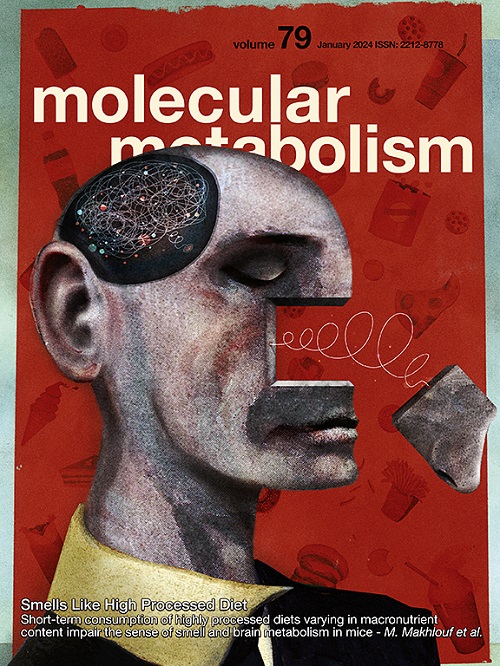人β细胞中甘氨酸受体活性的分子相关性
IF 7
2区 医学
Q1 ENDOCRINOLOGY & METABOLISM
引用次数: 0
摘要
目的甘氨酸通过其嗜离子受体(GlyRs)在人β细胞中参与自分泌正反馈回路。在2型糖尿病(T2D)中,胰岛GlyR活性受到未知机制的损害。我们试图研究t2dm的GlyR功能障碍是否被高血糖本身复制,并进一步表征其在β细胞和胰岛中的作用。方法采用全细胞膜片钳对来自供体的β细胞进行glr介导的电流测量,这些β细胞有或没有T2D,或经过高糖(15 mM)培养。我们还通过patch-seq将甘氨酸诱导的电流振幅与转录物表达水平联系起来。比较t2dm供体和非t2dm供体以及高糖培养后胰岛GlyR α1、α3和β亚基mRNA剪接变异体的表达。在GlyR拮抗剂士的宁存在或不存在的情况下,测量了人胰岛的胰岛素分泌。结果t2t2胰岛GlyRs基因表达降低,β细胞GlyR介导的电流减小,但GlyR亚基剪接未发生变化。无糖尿病供体胰岛在高糖环境下培养48小时后,甘氨酸诱导的电流也减少,α1亚基表达减少,但α3亚基表达增加。研究人员发现,甘氨酸诱发电流在β细胞中具有高度异质性,与供体HbA1c呈负相关,并与包括CREB3(+)、RREB1(+)和ZNF697(+)在内的92种不同转录本和基因调控网络(grn)的表达显著相关。最后,在GlyR拮抗剂士的宁的存在下,葡萄糖刺激的胰岛素分泌减少。结论葡萄糖可以调节GlyR的表达,目前T2D的下降可能是由于受体基因表达下调,而不是转录物剪接的变化。此外,我们定义了一组先前未知的基因和调控,这些基因和调控与GlyR介导的电流相关,并可能参与T2D中GlyR的下调。其中,我们验证了EIF4EBP1表达对GlyR活性的负面影响。本文章由计算机程序翻译,如有差异,请以英文原文为准。
Molecular correlates of glycine receptor activity in human β cells
Objectives
Glycine acts in an autocrine positive feedback loop in human β cells through its ionotropic receptors (GlyRs). In type 2 diabetes (T2D), islet GlyR activity is impaired by unknown mechanisms. We sought to investigate if the GlyR dysfunction in T2D is replicated by hyperglycemia per se, and to further characterize its action in β cells and islets.
Methods
GlyR-mediated currents were measured using whole-cell patch-clamp in human β cells from donors with or without T2D, or after high glucose (15 mM) culture. We also correlated glycine-induced current amplitude with transcript expression levels through patch-seq. The expression of the GlyR α1, α3, and β subunit mRNA splice variants was compared between islets from donors with and without T2D, and after high glucose culture. Insulin secretion from human islets was measured in the presence or absence of the GlyR antagonist strychnine.
Results
Although gene expression of GlyRs was decreased in T2D islets, and β cell GlyR-mediated currents were smaller, we found no evidence for a shift in GlyR subunit splicing. Glycine-induced currents are also reduced after 48 h culture of islets from donors without diabetes in high glucose, where we also find the reduction of the α1 subunit expression, but an increase in the α3 subunit. We discovered that glycine-evoked currents are highly heterogeneous amongst β cells, inversely correlate with donor HbA1c, and are significantly correlated to the expression of 92 different transcripts and gene regulatory networks (GRNs) that include CREB3(+), RREB1(+) and ZNF697(+). Finally, glucose-stimulated insulin secretion is decreased in the presence of the GlyR antagonist strychnine.
Conclusions
We demonstrate that glucose can modulate GlyR expression, and that the current decrease in T2D is likely due to the receptor gene expression downregulation, and not a change in transcript splicing. Moreover, we define a previously unknown set of genes and regulons that are correlated to GlyR-mediated currents and could be involved in GlyR downregulation in T2D. Among those we validate the negative impact of EIF4EBP1 expression on GlyR activity.
求助全文
通过发布文献求助,成功后即可免费获取论文全文。
去求助
来源期刊

Molecular Metabolism
ENDOCRINOLOGY & METABOLISM-
CiteScore
14.50
自引率
2.50%
发文量
219
审稿时长
43 days
期刊介绍:
Molecular Metabolism is a leading journal dedicated to sharing groundbreaking discoveries in the field of energy homeostasis and the underlying factors of metabolic disorders. These disorders include obesity, diabetes, cardiovascular disease, and cancer. Our journal focuses on publishing research driven by hypotheses and conducted to the highest standards, aiming to provide a mechanistic understanding of energy homeostasis-related behavior, physiology, and dysfunction.
We promote interdisciplinary science, covering a broad range of approaches from molecules to humans throughout the lifespan. Our goal is to contribute to transformative research in metabolism, which has the potential to revolutionize the field. By enabling progress in the prognosis, prevention, and ultimately the cure of metabolic disorders and their long-term complications, our journal seeks to better the future of health and well-being.
 求助内容:
求助内容: 应助结果提醒方式:
应助结果提醒方式:


